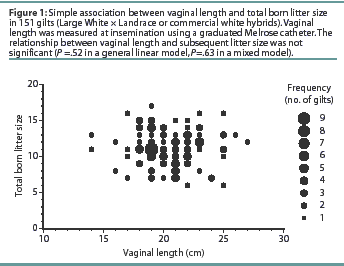Brief communication
Peer reviewed
Vaginal length is not related to subsequent litter size of gilts
Casimiro Tarocco, DVM; Roy Kirkwood, DVM, PhD
CT: DIPROVAL, Sezione Allevamenti Zootecnici, University of Bologna, 42100 Regio Emilia, Italy; RNK: Department of Large Animal Clinical Sciences, Michigan State University, East Lansing, MI 48824-1314.
Casimiro T, Kirkwood R. Vaginal length is not related to subsequent litter size of gilts. J Swine Health Prod. 2002;10(3):125-126. Also available as a PDF.
Summary
This study determined the relationship between vaginal length and subsequent gilt litter size. Vaginal length was determined using a calibrated Melrose catheter at the time of artificial insemination at the second estrus. There was no significant relationship between vaginal length and either gilt age or subsequent litter size.
Keywords : swine, vaginal length,
litter size
: swine, vaginal length,
litter size
Received: August 21, 2001
Accepted: February 7, 2002
It has recently been reported that the length of the vagina plus vestibule (vaginal length) in gilts is related to the length of the uterus, with a 1-cm increase in vaginal length corresponding to an 8- to 9-cm increase in uterine length.1 Uterine size also increases with gilt age and number of estrus cycles.1 It was suggested that an increased uterine length would increase uterine capacity and so result in larger litters. Indeed, these same authors have documented a positive relationship between gilt vaginal length at the time of insemination at their second estrus and their first litter size.2 Given the ease with which vaginal length can be measured, and the potential utility of such a measurement in selecting gilts for increased litter size, a further study was warranted.
Materials and methods
This study was performed on a 900-sow farrow-to-finish commercial facility in the Po River plains of Italy between September and November 1999. From 24 to 28 weeks of age, 151 gilts (Large White x Landrace or commercial white hybrids) were housed in groups of 12 to 15 and exposed daily to a boar to facilitate onset and detection of their pubertal estrus. After detection of estrus, gilts were individually housed in gestation crates. Gilts were artificially inseminatedwith 3 x 109 sperm in 80 mL of Beltsville Thawing Solution3 at the detection of their second estrus and again 24 hours later. One person using a graduated Melrose catheter performed all inseminations. Vaginal length was recorded at the second insemination, after insertion of the catheter into the cervix as described by Martin Rillo et al.2
Using SAS (Statistical Analysis Systems, Cary, North Carolina), a general linear model was created with litter size as the dependent variable and vaginal length, boar ID, gilt genotype, and gilt age as fixed independent variables. Significance level was assessed by type III sum of squares. A second multivariable model, using the SAS procedure for mixed models, included litter size as the dependent variable, vaginal length, genotype, and gilt age as fixed effects independent variables, and boar as a random effect independent variable.
Results
Subsequent litter size was affected by gilt age (P<.02) and gilt genotype (P<.05). However, there was no effect of vaginal length (range 14 to 27 cm) on subsequent litter size in either the general linear model (P=.52) or the mixed model (P=.63) (Figure 1). There was no significant relationship between gilt age and vaginal length.

Discussion
That subsequent litter size was affected by gilt age but not vaginal length indicates that gilt age is a better predictor of subsequent litter size than is vaginal length. It is often suggested that first litter size increases with breeding at successive estrus periods due to increasing ovulation rates. However, this effect is apparent only when gilts become pubertal at young ages and (or) light weights, suggesting that it is the increasing age and weight that mediates this effect.4 An alternative hypothesis is that, for young gilts, the effect of breeding at a later estrus period is mediated by an increasing uterine capacity driven by estrus-associated endocrine changes.
It was not possible in this study to directly examine the relationship between vaginal length and uterine size. However, previous authors examining this relationship have suggested that subsequent litter size is an effective indirect measure.1,2 The lack of effect of increasing vaginal length on litter size observed in the present study indicates that, within the limits of vaginal length in the present study, the two measures are not significantly related. However, in this study and in previous studies, changes in vaginal length within gilt at successive estrus periods were not measured. It would be interesting to examine the relationship between vaginal length at the second estrus and subsequent litter size and relate this to vaginal length at puberty. Although speculative, it is possible that for gilts with some minimum vaginal length at puberty there will be no increase in litter size as a result of breeding at the second estrus.
Implication
- The measurement of vaginal length in gilts bred at second estrus does not provide an indication of subsequent litter size.
References - refereed
2. Martin Rillo S, De Alba Romero C, Romero Rodriguez A, Cidoncha R, Ziecik AJ. Litter size and vagina-cervix catheter penetration length in gilts. Reprod Dom Anim. 2001;36:297-300.
3. Pursel VG, Johnson LA. Freezing of boar spermatozoa: fertilizing capacity with concentrated semen and a new thawing procedure. J Anim Sci. 1975;40:99-102.
References - non refereed
1. Martin Rillo S, De Alba C, Falceto V, Peralta W, Bustamante J. Importance du development de l'appareil genital des cochettes pour la future productivite de la truie. Proc Recontres Internationales de Production Porcine. Loudeac, France. 1998;11-16.
4. Kirkwood RN, Thacker PA. Management of replacement breeding animals. Vet Clin North Am Food Anim Pract. 1992;8:575-587.
